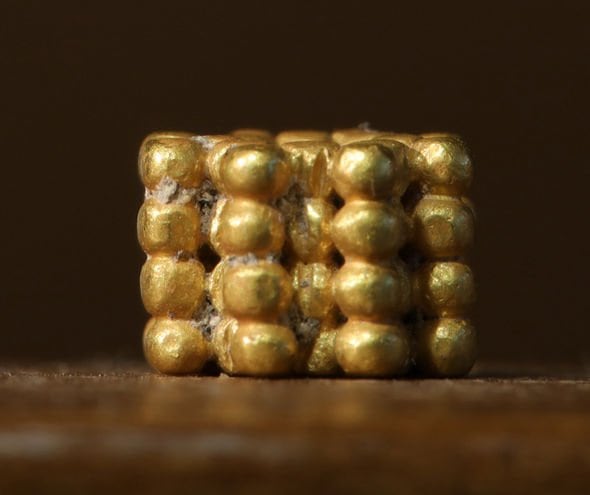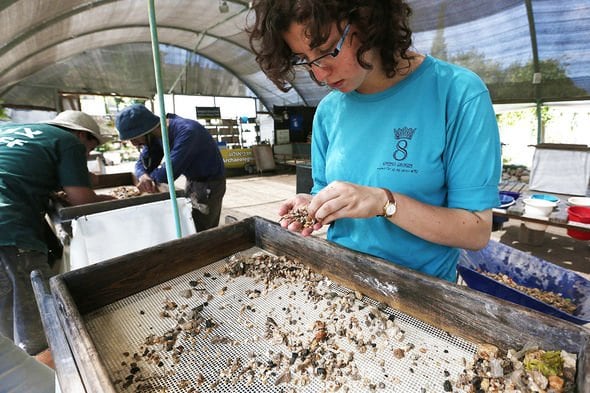Viky, díky za článek a hlavně posílám veliké poděkování za přípravu celoročního kalendária. Je zajímavé si něco nového přečíst, něco se dozvědět, něco se přiučit. Také celá příprava zabere dost času. Proto ještě jednou - díky. 
Three thousand year old jewel
Categories: Finds and rescue research abroad , Nálezy nejenom s detektorem na blízkém východě
The precious gold bead was found by a nine-year-old boy in Israel. The 3,000-year-old jewel is made of tiny beads. It's a typical method of the so-called First Temple period.
The rare 3,000-year-old discovery was made by a nine-year-old boy in the area of the so-called Temple Mount, which has long been explored by archaeologists. The incredible initiative, which began sixteen years ago, is a testament to how well professional and amateur archaeologists from around the world can work together. They have already found 480,000 artefacts, including ancient coins and pottery.
The Temple Mount is a plateau with the plan of an irregular quadrangle located in Jerusalem's Old City.However, objects made of gold are also rare here, as this precious metal was not available in Israel in the past. We are talking primarily about the First Temple period, around 957 BC.
Archaeologists were therefore thrilled when a nine-year-old boy, Binyamin Milt, found a gold bead from the First Temple period. "We actually find gold jewellery from this period very rarely. Back then, gold usually contained a large percentage of silver. In ancient Egypt, gold was attributed magical significance due to its brilliance and ability to withstand time," noted archaeologist Amir Golani.
The bead found is composed of small gold balls arranged in the shape of a flower. There is a hole in the middle, about six by four millimetres, to allow the bead to be strung. For the period of the First Temple, jewellery made in the style of gluing small beads was really common. They also made silver jewelry this way.
In the Holy Land, according to biblical sources, they apparently used gold from what is now Saudi Arabia and the Horn of Africa. Other sources also suggest that the precious metal may have traveled to Israel from the Mediterranean along trade routes from Greece and Spain. Archaeologists have previously uncovered similar examples of jewelry at some of Israel's oldest sites.
"We found similar beads during the excavation of a burial site at the Ketef Hinnom archaeological site. They also date back to the First Temple period, were identical in shape, but made of silver," revealed archaeologist Gaby Barkay.
The production of jewellery in this style is a rather complicated process in which the craftsman in question must be able to melt the metal at high temperatures. Beads of the same type have been found at other sites around Israel. For example, in the ancient cities of Tel Megiddo, Tel el-Ajjul and Tel el-Farah. They were worn on necklaces and belts.



Sources: www.express.co.uk
The article is included in categories:
- Archive of articles > Archaeology > Finds and rescue research abroad
- Archive of articles > Archaeology > Finds and rescue research abroad > Nálezy nejenom s detektorem na blízkém východě
Post
Já taky děkuji za komentáře. Vždycky potěší  Zabere to dost času, ale dozvěděla jsem se a oživila si spoustu věcí. Píšu sem moc ráda
Zabere to dost času, ale dozvěděla jsem se a oživila si spoustu věcí. Píšu sem moc ráda  Přeju všechno nejlepší do nového roku
Přeju všechno nejlepší do nového roku 
Také se přidávám s velkým díky za tvoje poutavé a ne zřídka velmi zajímavá čtení.. snad ta jednička bude pro další tvorbu výborný začátek! .. hlavně zdraví přeji!😉
Též se připojuji s díky a přáním všeho dobrého! 









